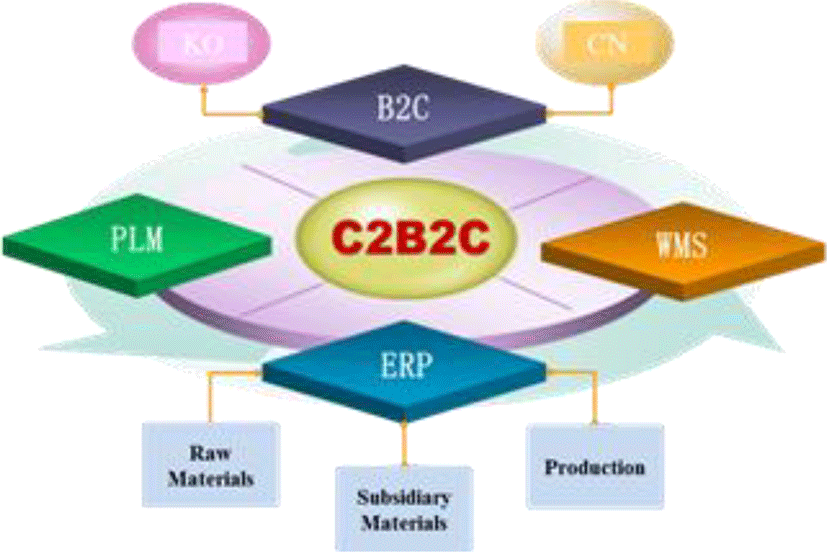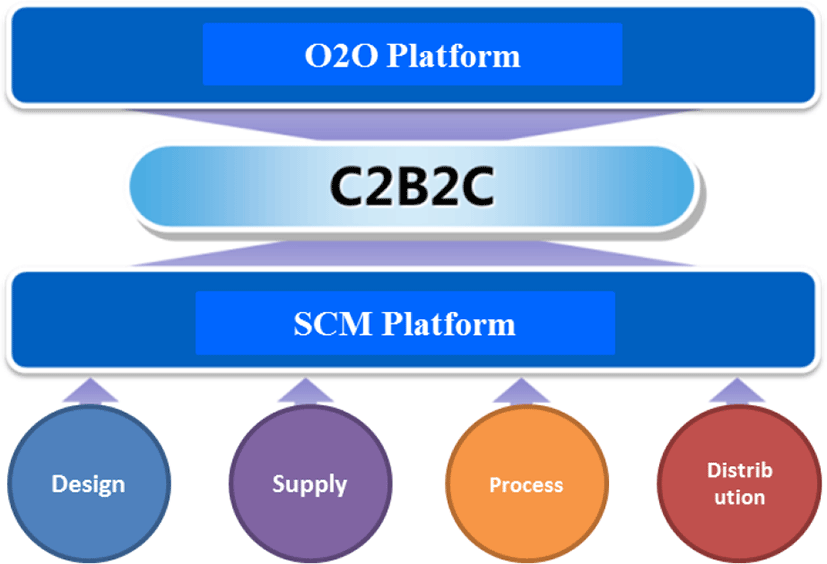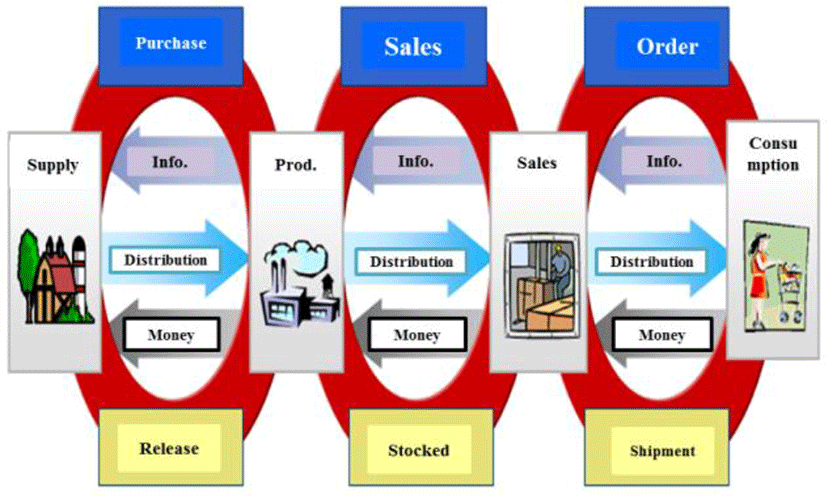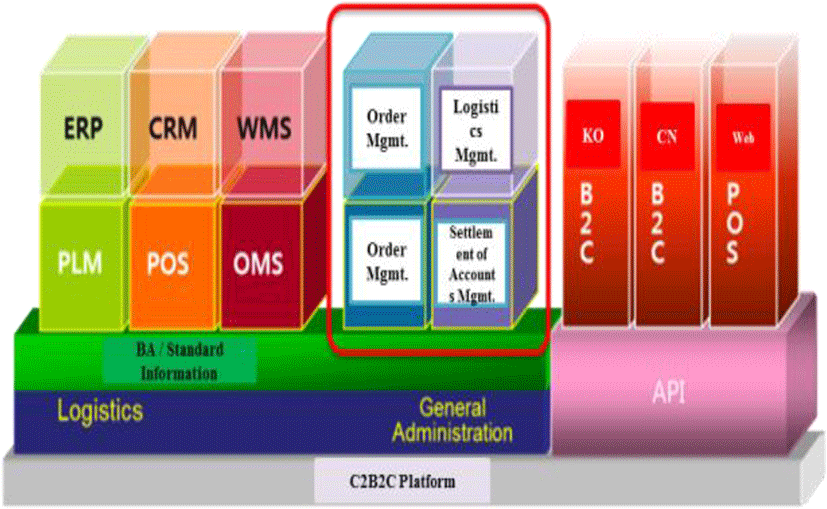I. INTRODUCTION
In recent years, the size of the Chinese online shopping market has been growing rapidly. For instance, the size of the online shopping market in 2008 was 12.9 billion yuan which was approximately 18.4 billion U.S. dollars, but it reached 1.85 trillion yuan in 2013, which is more than 10 times bigger than the size of online shipping market in 2008 [1]. Additionally, one of the biggest online shopping mall companies, Alibaba, turned over approximately 90 billion yuan through a singles’ day event on November 11th, 2015. Most Chinese companies could make 20% of the annual sales through this event, and it had a significant impact on overseas companies in Korea, Japan, U.S., etc.
Due to this trend, this paper proposes the C2B2C business model based on the concept of C2B (Customer-to-Business) Commerce targeting the clothing industry. This model enables integrated management of cloth design, selection of raw materials, clothing process, and product distribution.
The following are research methodologies. First, we analyzed purchasing tendencies of clothes such as consumers’ shopping motive, shopping complaints, and product distribution (online and offline store). Second, we analyzed the correlation of the consumers, product designers, and companies between the C2B and B2C (Business-to-Customer) environments and designed a business in terms of design, production, distribution, and sales process of the clothes. Third, we integrated a B2C platform with a SCM platform, and then designed it for sharing and obtaining accurate information in real time by synchronizing information such as order, sales, production, supply, settlement of accounts of the clothes through an O2O (Online to Offline) method. Lastly, once shipping is confirmed, the C2B2C platform automatically calculates a net income for product designers, processing companies, and shipping companies.
II. LITERATURE RESEARCH
C2B is a business model in which consumers offer price, quantity, or services, and the suppliers or manufacturers pay the customers. Customers can secure enough product information through the Internet so that it is possible to do business on the same footing as manufacturers [2].
B2C is a business model between companies and consumers. Generally, companies directly sell products to individuals. Production / sales companies fulfill consumer’s needs through the effective marketing strategies [3].
O2O is a business model to attract consumers from online shopping malls to offline malls; in other words, after customers purchase products and make a payment online, they receive products at an offline store [4].
When social commerce in China was first introduced in 2010, many companies followed the O2O business model. Yet, the main problem of the O2O business model was that it had a very simple management system so that many shopping malls went broken. For this reason, it needed to complement the existing O2O business model [5].
According to evaluation of the online brand clothes targeted at male consumers, it showed that color was the most important factor, and the least important factor was ease of laundry and management. The following shows factors that affected purchasing tendency based on importance: color > activity > design > sewing condition > quality > size > product elasticity, breathability, and hygroscopicity > grain > durability > ease of laundry and management. [6].
Additionally, Sun Hye Yoon classified teenage boys and girls into 4 different groups of pursuit of convenience and fashion trend, pleasure seeking, brands, and low involvement of shopping and figured out that each group showed a significant difference in terms of the number of site visits [7].
Byungsuk Hong et. al. figured out that 3 different consumer groups of pursuit of information, diversity, and innovativeness showed a significant difference in terms of shopping absorption [8].
Sunghee Kim categorized shopping tendency into 4 different aspects including pleasure, convenience, financial aspect, and fashion and found out that there was also a significant difference in terms of purchasing behavior (purchasing frequency, purchasing intension, and the number of site visits) [5].
Sehee Kim classified clothing shopping tendency into pursuit of rationality, shopping enjoyment, purpose-oriented, sympathy-oriented, brand, convenience, and impulse purchasing. The author found out that online shopping customers had bigger shopping tendency than offline customers in terms of shopping enjoyment and purpose-oriented [9].
Customers were categorized according to the quantity of purchasing fashion items on the Internet shopping mall. The author analyzed their shopping tendency and figured out that a middle purchasing class showed higher pleasure seeking and fashion consciousness than a low purchasing class [10].
Mee-Ae Jeon conducted research focusing on Internet shopping addiction. 4 groups were identified, i.e. addictive group, high risk group, potential group, and non-addictive group. The author pointed out that there was a significant difference between groups in terms of shopping preference, item value, time saving, and materialism [11].
Based on the researched literature above, purchasing tendency affect consumers according to distribution channels (online and offline stores). Since consumers prefer price rather than quality and design of the clothing products, companies are required to differentiate distribution channels and distribution management. Due to such differentiation, it is also required to establish strategies focusing on product development, product addition, price discount, etc. Marketing system implementation, enhancement of the long term brand value, excellent salesperson selection and evaluation should be performed through communication between distribution centers and sales people [12].
Therefore, we integrated a consumption platform with a SCM platform based on the O2O method with consideration of these factors and designed the C2B2C business model that enables integrated support to design, supply, process, and distribution of the clothes.
III. C2B2C BUSINESS MODEL DESIGN
The fundamental concept of the C2B2C business model is a combination of B2C and the order method of C2B. Based on that, a product designer can produce a product once a consumer selects the product design. To realize this concept, it is required to integrate the ordering methods of B2C (App and Web), OMS, and POS with the C2B2C to handle order and shipping information automatically. The following Figure 1 shows the fundamental concept of the C2B2C.
The C2B2C business model integrates a consumption platform with a SCM platform under the O2O environment shown in Figure 2.
The Table 1 shows the core components of the C2B2C business model.
The business processes of the C2B2C business model are shown in Figure 3.
The following Table 2 shows a detailed description of each business process in the C2B2C business model.
The functional structure of the C2B2C business model consists of 3 major models shown in Figure 4.
IV. CONCLUSION
In this paper, C2B orders are integrated with B2C sales in the O2O environment. We designed integrated support platform that offers design, supply, processing, and distribution of a fashion business. There are several expected outcomes through use of this model.
-
All the information such as orders, sales, production, supply, and settlement of accounts can be synchronized so that it is possible to share accurate information in real time.
-
Customers can secure enough information so that they as consumers can suggest conditions such as price, quantity, and so on to manufacturer.
-
Multiple core strategies such as product development, salesperson incentive, etc. can be established so that long term brand value promotion can be expected.
-
A net income of the product designers, processing companies, and shipping companies is automatically calculated once shipping is confirmed.
Our future work will focus on designing a specific business unit for integration of the business processes between Korean and Chinese companies, and then analyze expected outcomes after implementation.











